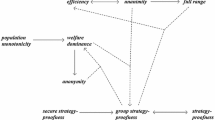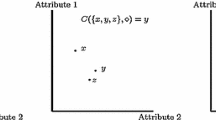Abstract
The strict dominance principle that a wager always paying better than another is rationally preferable is one of the least controversial principles in decision theory. I shall show that (given the Axiom of Choice) there is a contradiction between strict dominance and plausible isomorphism or symmetry conditions, by showing how in several natural cases one can construct isomorphic wagers one of which strictly dominates the other. In particular, I will show that there is a pair of wagers on the outcomes of a uniform spinner which differ simply in where the zero degrees point of the spinner is defined to be but where one wager dominates the other. I shall also argue that someone who accepts Williamson’s famous argument that the probability of an infinite sequence of heads is zero should accept the symmetry conditions, and thus has reason to weaken the strict dominance principle, and I shall propose a restriction of the principle to “implementable” wagers. Our main result also has implications for social choice principles.
Similar content being viewed by others
Notes
This condition is related to the condition that \(P(\{ \omega : W_2(\omega ) = W_1(\omega ) \})=0\), but is weaker. For instance, it may be that the set \(\{ \omega : W_2(\omega ) = W_1(\omega ) \}\) is not P-measurable, even though it is contained in a set with P-measure zero.
Actually, all we need is that \(P(\Omega )\ne 0\).
First, there is exactly one member b in E such that \(a\sim b\), since E contains exactly one element from each equivalence class. Now suppose a can be obtained by rotating b by nx degrees as well as by mx degrees for integers n and m. We must show that \(n=m\). But the only way rotation by nx degrees and one by mx degrees applied to b can both yield the same point a is if \(nx-mx=(n-m)x\) is an integral multiple of 360. But since x is irrational, this can only happen if \(n-m=0\).
I am grateful to an anonymous reader for these observations.
The union of a countable sequence of finite sets is countable.
The only difference is that in the last step of the proof where we will need to show that \(\int _{\{H,T\}^\mathbb {Z}} (W^\rho -W) \, dP>0\), we won’t have a guarantee that \(W^\rho -W>0\) everywhere, but only that this happens outside of a set of measure zero. But that’s enough for the integral to be strictly positive.
Solovay (1970) has famously shown that assuming a certain large cardinal assumption, the existence of a non-measurable set requires some version of the Axiom of Choice. If the assumption holds, then any paradoxical wager like the one in the spinner case requires the Axiom of Choice. Note, however, that the fact that the proof of something requires the Axiom of Choice does not prove that the thing cannot be uniquely specified, as Kanovei and Shelah’s (2004) “construction” of a free ultrafilter on an infinite set shows.
Note that Proposition 2 becomes false if “countably additive” is replaced by “finitely additive”, at least given the Axiom of Choice. Let \(G=\Omega =\mathbb {Z}\) be the integers, acting on themselves by addition. Since \((\mathbb {Z},+)\) is a commutative group, it is amenable (2016, Theorem 12.4), i.e., there is a finitely additive \(\mathbb {Z}\)-invariant probability measure \(\mu \) on \(\mathbb {Z}\). Invariance implies that every singleton has the same measure, and finite additivity forces that measure to be zero, so again by finite additivity the measure of every finite set is zero. Let \(W_1\) be the wager that is zero everywhere and let \(W_2(n)=1/(1+|n|)\). Then \(W_2\) strictly dominates \(W_1\), but \(0 \le \int _\Omega W_2 \, d\mu \le 1/n\) for every positive integer n, since \(W_2 \le 1/n\) everywhere except on the finite set \(\{-(n-2),\dots ,n-2\}\) which has \(\mu \)-measure zero, so \(\int _\Omega W_2 \, d\mu = 0\), which is also what the integral of \(W_1\) equals.
In the case of the spinner, we can reflect the result in a line through the center of the spinner. In the lottery, for any fixed m such that 2m is an integer, we can map an outcome n to its reflection \(m-n\) around m, and in the coin toss example, for any such m, we can map \(\omega \) to \(\omega _m\) defined by \(\omega _m(n)=\omega (m-n)\).
A rotation by an angle \(\alpha \) can be generated by reflecting about a line at angle \(\alpha /2\) and then a line at angle \(3\alpha /2\); a translation by a distance x can be generating by reflecting about the point x/2 and then the point 3x/2.
I am grateful to an anonymous reader for pointing me to these applications.
That said, in this special case the non-existence of such a preference structure does not need the Axiom of Choice and is in fact obvious. Suppose the sites have integer coordinates (x, y, z). Let \(W(x,y,z) = \phi (x)\) for any strictly increasing bounded function \(\phi \) (e.g., \(\arctan \)) and let \(\tau \) be translation by one unit to the right along the x-axis. Then \(W(x,y,z) < W(x+1,y,z) = W^\tau (x,y,z)\) for all sites (x, y, z), and hence a translation-invariant preference structure cannot satisfy the weak Pareto condition.
I am grateful to John Norton for pointing me to the connection between my spinner construction and his Vitali set lottery, and to two anonymous readers for a careful reading and a number of suggestions that have significantly improved the paper.
References
de Finetti, B. (1937). Foresight: Its logical laws, its subjective sources. In H. E. Kyburg & H. E. K. Smokler (Eds.), Studies in Subjective Probability. Huntington: Kreiger Publishing.
Easwaran, Kenny. (2021). A new method of value aggregation. Proceedings of the Aristotelian Society, 121, 299–326.
Jonsson, A., & Peterson, Martin. (2020). Consequentialism in infinite worlds. Analysis, 80, 240–248.
Joyce, J. M. (1998). A nonpragmatic vindication of probabilism. Philosophy of Science, 65, 575–603.
Kanovei, V., & Shelah, S. (2004). A definable nonstandard model of the reals. Journal of Symbolic Logic, 69, 159–164.
Norton, J. D. (2020). How NOT to build an infinite lottery machine. Studies in History and Philosophy of Science, 82, 1–8.
Norton, J.D., & Parker, M. W. Forthcoming. “An Infinite Lottery Paradox”. Axiomathes.
Pettigrew, Richard. (2016). Accuracy and the Laws of Credence. Oxford: Oxford University Press.
Pettigrew, R. (2021). On the expected utility objection to the Dutch Book argument for probabilism. Noûs, 55, 23–38.
Pruss, A. R. (2013). Null probability, dominance and rotation. Analysis, 73, 682–685.
Pruss, A. R. (2014). Linear extensions of orders invariant under abelian group actions. Colloquium Mathematicum, 137, 117–125.
Pruss, A. R. (2018). Infinity, causation and Pp. Oxford: Oxford University Press.
Ramsey, F. P. (1931). Truth and probability. The foundations of mathematics and other logical essays (pp. 156–198). London: Routledge and Kegan Paul.
Solovay, R. M. (1970). A model of set-theory in which every set of reals is Lebesgue measurable. Transactions of the American Mathematical Society, 92(1), 1–56.
Szpilrajn, Edward. (1930). Sur l’extension de l’ordre partiel. Fundamenta Mathematicae, 16, 386–389.
Tomkowicz, G., & Wagon, S. (2016). The Banach Tarski Paradox (2nd ed.). Cambridge: Cambridge University Press.
Williamson, Timothy. (2007). How probable is an infinite sequence of heads? Analysis, 67, 173–180.
Funding
No funding beyond faculty salary was received.
Author information
Authors and Affiliations
Corresponding author
Additional information
Publisher's Note
Springer Nature remains neutral with regard to jurisdictional claims in published maps and institutional affiliations.
Appendix: Some proofs
Appendix: Some proofs
Proof of Proposition 1
We will show (i)\(\rightarrow \)(iii)\(\rightarrow \)(iv)\(\rightarrow \)(ii)\(\rightarrow \)(i).
That (i) implies (iii) is clear: if we had \(V^g\) strictly dominating V and yet \(\precapprox \) was a G-invariant preference structure satisfying strict dominance, then by strict dominance we would have \(V\prec V^g\), contrary to G-invariance.
Now we show that (iii) implies (iv). Assume (iv) is false. Thus there is a symmetry g such that \(g^n \omega \ne \omega \) whenever \(n>0\) and \(\omega \in \Omega \). More generally, it follows that if \(g^n \omega = g^m \omega \), then \(n=m\). For, otherwise, we could suppose without loss of generality that \(n>m\) and we would have \(g^{n-m} \omega = \omega \).
Let \(a\sim b\) if and only if \(a=g^n b\) for some integer n. Then \(\sim \) is an equivalence relation, and we can let E contain exactly one element from each equivalence class by Choice. Given \(a\in \Omega \), let \(b\in E\) be such that \(a=g^n b\) for some integer n. The integer n is unique, since otherwise we would have \(g^n b = g^m b\) for distinct n and m. Let \(U(a)=n\), observe that \(U^g(a)=U(a)+1\) and, as before, let \(V(a)=\phi (U(a))\) for a bounded strictly increasing \(\phi \). Then \(V^g\) strictly dominates V, and we have not-(iii).
Now we show (iv) implies (ii). Assume (iv). Say that \(V \precapprox W\) just in case there is a \(g\in G\) such that \(V(\omega ) \le W^g(\omega )\) for all \(\omega \in \Omega \). Then \(\precapprox \) is a G-invariant partial preorder, and it clearly satisfies the Principle of Non-Strict Dominance. We now show that it satisfies Strict Dominance as well. For suppose it does not, so that there are \(W_1\) and \(W_2\) such that \(W_1 < W_2\) everywhere but not \(W_1 \prec W_2\). By Non-Strict Dominance, we have \(W_1 \precapprox W_2\). Thus, for \(W_1 \prec W_2\) to fail, we must also have \(W_2 \precapprox W_1\). Hence there is a \(g\in G\) such that \(W_2 \le W_1^g\) everywhere. Therefore, \(W_2 < W_2^g\) everywhere, since \(W_1 < W_2\) everywhere. By (iv), there is a positive n and an \(\omega \) such that \(g^n\omega = \omega \). We then have \(W_2(\omega )< W_2(g\omega )< W_2(g^2\omega )< \dots < W_2(g^n\omega )\), which contradicts \(g^n\omega =\omega \).
However, \(\precapprox \) may be only a partial preorder, and we need a total one. To that end, let [W] be the equivalence class of the wager W under the relation \(\approx \) (where, recall, \(W_1\approx W_2\) if and only if \(W_1\precapprox W_2\) and \(W_2\precapprox W_1\)). Define the partial order \(\preceq \) on these equivalence classes by stipulating that \([W]\preceq [V]\) if and only if \(W\precapprox V\) (this is well defined because \(\precapprox \) is transitive). By the Szpilrajn order extension theorem (Szpilrajn, 1930) (this uses the Axiom of Choice), we can extend \(\preceq \) to a total order \(\preceq ^*\). Now define \(W_1\precapprox ^* W_2\) if and only if \([W_1]\preceq ^* [W_2]\). Then \(\precapprox ^*\) is easily seen to be a total preorder that extends \(\precapprox \). It is strongly G-invariant because it extends the strongly G-invariant preorder \(\precapprox \). It remains to check that \(\precapprox ^*\) satisfies the Principles of Non-Strict and Strict Dominance. Non-Strict Dominance follows from the fact that \(\precapprox ^*\) extends \(\precapprox \) and the latter satisfies Non-Strict Dominance. That leaves the Strict case. Suppose \(W_2\) strictly dominates \(W_1\). By Strict Dominance for \(\precapprox \), we have \(W_1 \prec W_2\). Therefore, \([W_1] \preceq [W_2]\) and not \([W_2] \preceq [W_1]\). Hence \([W_1] \preceq ^* [W_2]\), since \(\preceq ^*\) extends \(\preceq \). Since we do not have \([W_2] \preceq [W_1]\), we have \([W_2]\ne [W_1]\), and since \(\preceq ^*\) is an order, and not merely a preorder, it follows that we do not have \([W_2] \preceq ^* [W_1]\). Thus, we have \(W_1 \precapprox ^* W_2\) but not \(W_2 \precapprox ^* W_1\).
Thus, (iv) implies (ii).
Finally, (ii) trivially implies (i), which completes the proof. \(\square \)
Rights and permissions
Springer Nature or its licensor (e.g. a society or other partner) holds exclusive rights to this article under a publishing agreement with the author(s) or other rightsholder(s); author self-archiving of the accepted manuscript version of this article is solely governed by the terms of such publishing agreement and applicable law.
About this article
Cite this article
Pruss, A.R. Strict dominance and symmetry. Philos Stud 180, 1017–1029 (2023). https://doi.org/10.1007/s11098-023-01921-x
Accepted:
Published:
Issue Date:
DOI: https://doi.org/10.1007/s11098-023-01921-x




